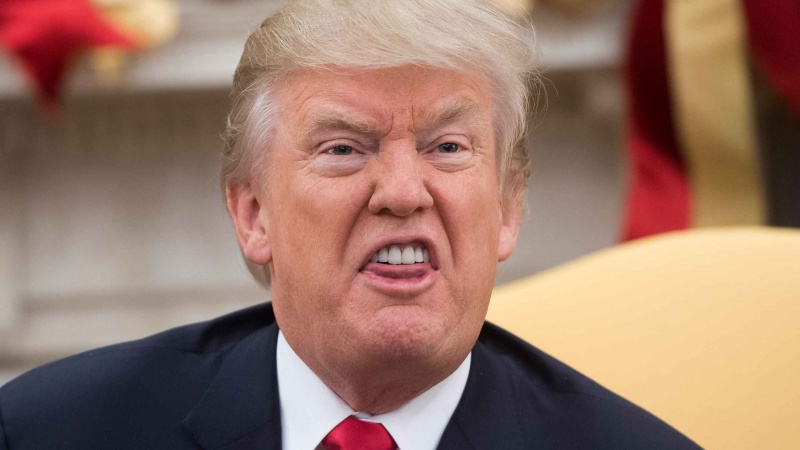20 ways Trump is copying Hitler’s rhetoric and policies (2)
The US president is behaving like the Nazi Dictator as is evident by his racist and discriminatory policies at home, and expansionist policies abroad, including the flexing of military muscles and economic terrorism against the Islamic Republic of Iran, in addition to his yearning to become president for life.
Stay with us for the second and concluding part of a well-researched article produced by ‘Voting Booth’, a project of the Independent Media Institute, and titled: “20 Ways Trump Is Copying Hitler’s Early Rhetoric and Policies”, on the basis of the investigation done by leading US civil rights lawyer Burt Neuborne, who questions whether the federal government can contain Donald Trump and the Republican Party’s power grabs
The writer is Steven Rosenfeld, a national political reporter focusing on democracy issues, who has written five books, “Democracy Betrayed: How Super Delegates, Party Insiders, and the Electoral College Rigged the 2016 Election”.
Point No. 10: Both Hitler and Trump embrace extreme nationalism. Hitler’s strident appeals to the base invoked an extreme version of German nationalism, extolling a brilliant German past and promising to restore Germany to its rightful place as a preeminent nation. Trump echoes Hitler’s jingoistic appeal to ultranationalist fervor, extolling American exceptionalism right down to the slogan ‘Make America Great Again,’ a paraphrase of Hitler’s promise to restore German greatness.
Point No. 11: Both Trump and Hitler made closing borders a centerpiece. Hitler all but closed Germany’s borders, freezing non-Aryan migration into the country and rendering it impossible for Germans to escape without official permission. Like Hitler, Trump has also made closed borders a centerpiece of his administration. Hitler barred Jews. Trump bars Muslims and seekers of sanctuary from Central America. When the lower courts blocked Trump’s Muslim travel ban, he unilaterally issued executive orders replacing it with a thinly disguised substitute that ultimately narrowly won Supreme Court approval under a theory of extreme deference to the president.
Point No. 12: They embraced mass detention and deportations. Hitler promised to make Germany free from Jews and Slavs. Trump promises to slow, stop, and even reverse the flow of non-white immigrants, substituting Muslims, Africans, Mexicans, and Central Americans of color for Jews and Slavs as scapegoats for the nation’s ills. Trump’s efforts to cast dragnets to arrest undocumented aliens where they work, live, and worship, followed by mass deportation echo Hitler’s promise to defend Germany’s racial identity. Trump has stooped to tearing children from their parents [as Nazis in World War II would do] to punish desperate efforts by migrants to find a better life.
Point No. 13: Both used borders to protect selected industries. Like Hitler, Trump seeks to use national borders to protect his favored national interests, threatening to ignite protectionist trade wars with Europe, China, and Japan similar to the trade wars that, in earlier incarnations, helped to ignite World War I and World War II. Like Hitler, Trump aggressively uses the US’ political and economic power to favor selected American corporate interests at the expense of foreign competitors and the environment, even at the price of international conflict, massive inefficiency, and irreversible pollution [climate change].
Point No.14: Both Hitler and Trump cemented their rule by enriching elites. Hitler’s version of fascism shifted immense power—both political and financial—to the leaders of German industry. In fact, Hitler governed Germany largely through corporate executives. Trump has also presided over a massive empowerment—and enrichment—of corporate America. Under Trump, large corporations exercise immense political power while receiving huge economic windfalls and freedom from regulations designed to protect consumers and the labor force. Hitler despised the German labor movement, eventually destroying it and imprisoning its leaders. Trump also detests strong unions, seeking to undermine any effort to interfere with the prerogatives of management.
Point No. 15: Both Hitler and Trump rejected international norms. Hitler’s foreign policy rejected international cooperation in favor of military and economic coercion, culminating in the annexation of the Sudetenland, the phony Hitler-Stalin non-aggression pact, the invasion of Czechoslovakia, and the horrors of global war. Like Hitler, Trump is deeply hostile to multinational cooperation, withdrawing from the Trans-Pacific Partnership, the Paris Agreement on climate change, and the nuclear agreement with Iran, threatening to withdraw from the North American Free Trade Agreement, abandoning the Kurds in Syria, and even going so far as to question the value of NATO.
Point No. 16: Both Hitler and Trump attack domestic democratic processes. Hitler attacked the legitimacy of democracy itself, purging the voting rolls, challenging the integrity of the electoral process, and questioning the ability of democratic government to solve Germany’s problems. Trump has also attacked the democratic process, declining to agree to be bound by the outcome of the 2016 elections when he thought he might lose, supporting the massive purge of the voting rolls allegedly designed to avoid (nonexistent) fraud, championing measures that make it harder to vote, tolerating—if not fomenting—massive Russian interference in the 2016 presidential election, encouraging mob violence at rallies, darkly hinting at violence if Democrats hold power, and constantly casting doubt on the legitimacy of elections unless he wins.
Point No. 17: Both Hitler and Trump attack the judiciary and rule of law. Hitler politicized and eventually destroyed the vaunted German justice system. Trump also seeks to turn the American justice system into his personal playground. Like Hitler, Trump threatens the judicially enforced rule of law, bitterly attacking American judges who rule against him, slyly praising Andrew Jackson for defying the Supreme Court, and abusing the pardon power by pardoning an Arizona sheriff found guilty of criminal contempt of court for disobeying federal court orders to cease violating the Constitution.
Point No. 18: Both Hitler and Trump glorify the military and demand loyalty oaths. Like Hitler, Trump glorifies the military, staffing his administration with layers of retired generals (who eventually were fired or resigned), relaxing control over the use of lethal force by the military and the police, and demanding a massive increase in military spending. Just as Hitler imposed an oath of personal loyalty on all German judges and demanded courts defer to him, Trump’s already gotten enough deference from five Republican [Supreme Court] justices to uphold a largely Muslim travel ban that is the epitome of racial and religious bigotry.
Trump has also demanded loyalty oaths. He fired James Comey, a Republican appointed in 2013 as FBI director by President Obama, for refusing to swear an oath of personal loyalty to the president; excoriated and then sacked Jeff Sessions, his handpicked attorney general, for failing to suppress the criminal investigation into Trump’s possible collusion with Russia in influencing the 2016 elections; repeatedly threatened to dismiss Robert Mueller, the special counsel carrying out the investigation; and called again and again for the jailing of Hillary Clinton, his 2016 opponent, leading crowds in chants of ‘lock her up.’ A new chant, “send her back,” has since emerged at Trump rallies directed at non-white Democratic congresswomen – Alexandria Ocasio-Cortez of New York, Ilhan Omar of Minnesota, Ayanna Pressley of Massachusetts and Rashida Tlaib of Michigan.
Point No. 19: They proclaim unchecked power. Like Hitler, Trump has intensified a disturbing trend that predated his administration of governing unilaterally, largely through executive orders or proclamations, such as the Muslim travel ban, trade tariffs, unraveling of health and environmental safety nets, and efforts to end President Obama’s protection for poor. Like Hitler, Trump claims the power to overrule Congress and govern all by himself. In 1933, Hitler used the pretext of the Reichstag fire to declare a national emergency and seize the power to govern unilaterally. The German judiciary did nothing to stop him. German democracy never recovered.
When Congress refused to give Trump funds for his border wall even after he threw a tantrum and shut down the government, Trump, like Hitler, declared a phony national emergency and claimed the power to ignore Congress.
Nueborne says in this regard: “Don’t count on the Supreme Court to stop him. Five justices gave the game away on the President’s unilateral travel ban. They just might do the same thing on the border wall.” It did in late July, ruling that Trump could divert congressionally appropriated funds from the Pentagon budget—undermining constitutional separation of powers.
Point No. 20: Both Trump and Hitler relegate women to subordinate roles. Finally, Hitler propounded a misogynistic, stereotypical view of women, valuing them exclusively as wives and mothers while excluding them from full participation in German political and economic life. Trump may be the most openly misogynist figure ever to hold high public office in the United States, crassly treating women as sexual objects, using nondisclosure agreements and violating campaign finance laws to shield his sexual misbehavior from public knowledge, attacking women who come forward to accuse men of abusive behavior, undermining reproductive freedom, and opposing efforts by women to achieve economic equality.
The question that arises is that: Whither Constitutional Checks and Balances?
Most of Neuborne’s book is not centered on Trump’s fealty to Hitler’s methods and early policies. He notes, as many commentators have, that Trump is following the well-known contours of authoritarian populists and dictators: “there’s always a demagogic leader, a disaffected mass, an adroit use of communications media, economic insecurity, racial or religious fault lines, xenophobia, a turn to violence, and a search for scapegoats.”
The bigger problem, and the subject of most of the book, is that the federal architecture intended to be a check and balance against tyrants, is not poised to act. Congressional representation is fundamentally anti-democratic. In the Senate, politicians representing 18 percent of the national population—epicenters of Trump’s base—can cast 51 percent of the chamber’s votes. A Republican majority from rural states, representing barely 40 percent of the population, controls the chamber. It repeatedly thwarts legislation reflecting multicultural America’s values—and creates a brick wall for impeachment.
The House of Representatives is not much better. Until 2018, this decade’s Republican Party majority House, a product of 2011’s extreme Republican gerrymanders, was also unrepresentative of the nation’s demographics. That bias still exists in the Electoral College, as the size of a state’s congressional delegation equals its allocation of votes. That formula is fair as far as House members go, but allocating votes based on two senators per state hurts urban America. Consider that California’s population is 65 times larger than Wyoming’s.
Meanwhile, the Supreme Court’s majority remains in the hands of justices appointed by Republican presidents—and favors that party’s agenda. Most Americans are unaware that the court’s partisan majority has only changed twice since the Civil War—in 1937, when a Democratic-appointed majority took over, and in 1972, when a Republican-appointed majority took over. Senate Republican Majority Leader Mitch McConnell’s blocking of President Obama’s final nominee thwarted a twice-a-century change. Today’s hijacked Supreme Court majority has only just begun deferring to Trump’s agenda.
Neuborne wants to be optimistic that a wave of state-based resistance, call it progressive federalism, could blunt Trump’s power grabs and help the country return to a system embracing, rather than demonizing, individual dignity and fundamental equality. But he predicts that many Americans who supported Trump in 2016 (largely, he suggests, because their plights have been overlooked for many years by federal power centers and by America’s capitalist hubs) are not likely to desert Trump—not while he’s in power.
He says: “When tyrants like Hitler are ultimately overthrown, their mass support vanishes retroactively—everyone turns out to have been in the resistance—but the mass support was undeniably there. There will, of course, be American quislings who will enthusiastically support an American tyrant. There always are—everywhere.”
Ultimately, Neuborne doesn’t expect there will be a “constitutional mechanic in the sky ready to swoop down and save American democracy from Donald Trump at the head of a populist mob.” Whatever Trump thinks he is or isn’t doing, his rhetorical and strategic role model—the early Hitler—is what makes Trump and today’s Republican Party so dangerous.
Neuborne writes: “Even if all that Trump is doing is marching to that populist drum, he is unleashing forces that imperil the fragile fabric of a multicultural democracy. But I think there’s more. The parallels—especially the links between “Lügenpresse” and “fake news”, and promises to restore German greatness and ‘Make America Great Again’—are just too close to be coincidental. I’m pretty sure that Trump’s bedside study of Hitler’s speeches—especially the use of personal invective, white racism, and xenophobia—has shaped the way Trump seeks to gain political power in our time. I don’t for a moment believe that Trump admires what Hitler eventually did with his power [genocide], but he damn well admires—and is successfully copying—the way that Hitler got it.”
AS/SS



